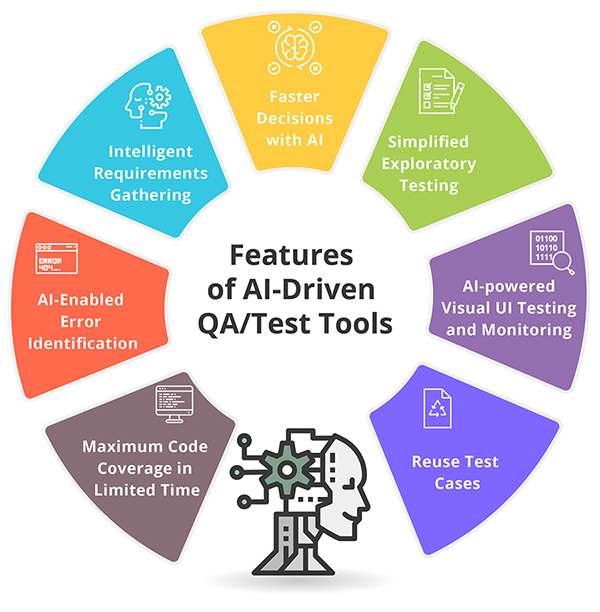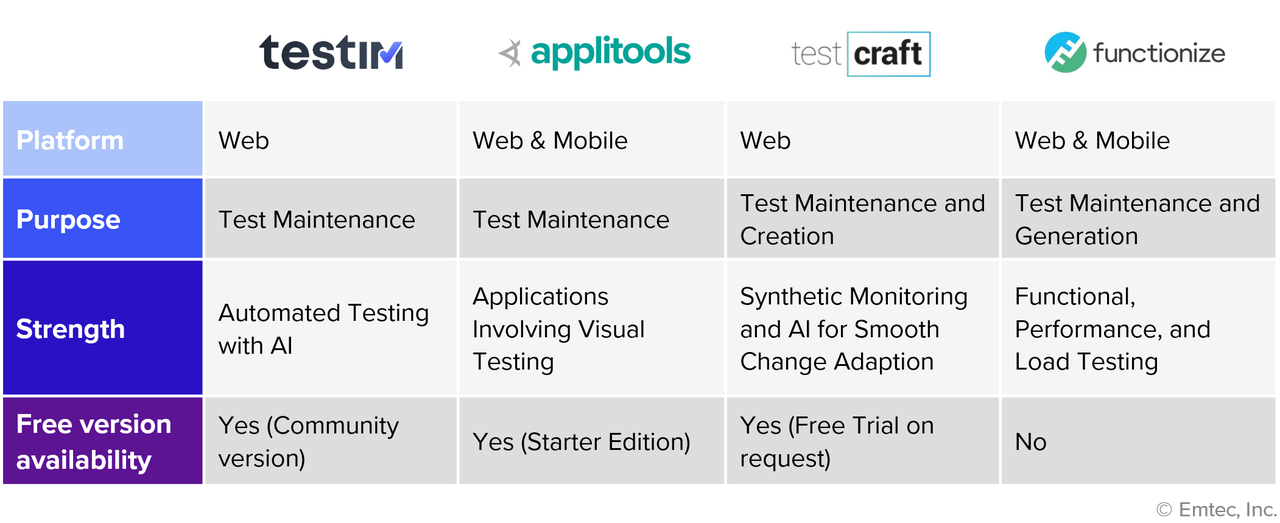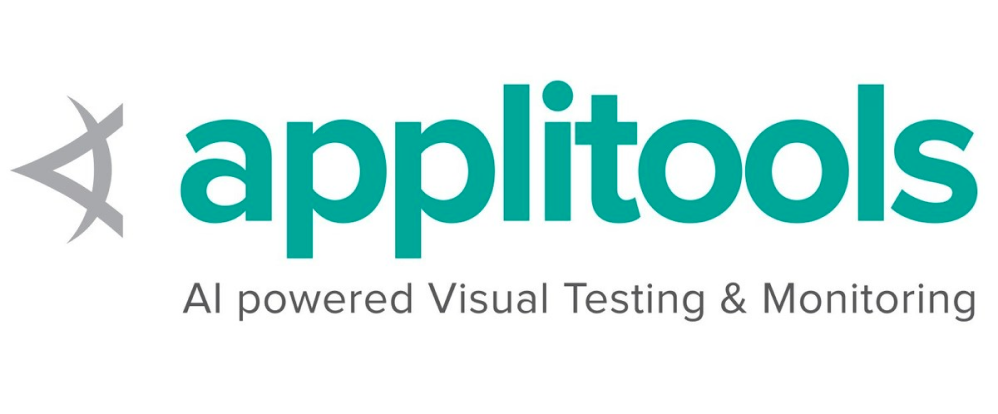Reasons why Quality Assurance will need AI
AI (Artificial Intelligence) is a technology-friendly invention revolutionizing industries with immense benefits and potential. It influences the quality assurance process, involving creating test data sets and data to check the system or software quality through the software development lifecycle.
In quality assurance, AI is of use to boost productivity and accuracy. In manufacturing, AI replaces manual inspections of parts and products as they move through production lines. AI-powered systems often use computer vision and deep learning models to scan and analyze components against accepted standards and to alert to defective items. This all makes production lines more efficient and helps prevent employee burnout.
AI can help us overcome these challenges and accelerate the testing process without human intervention. It can predict client behavior, detect fraudulence that is not captured with traditional functional tests, and assist in targeted marketing by replicating manual activities. It eliminates test coverage overlaps, optimizes test automation, and improves agility and predictability through self-learning. The QA teams can leverage AI testing tools to improve normal testing efforts with expedited time and greater accuracy.
How will AI help with Quality Assurance?

Fig 1. Features of AI-Driven QA/Test tools
Here are some essential and salient benefits of AI-driven Quality Assurance:
- Reduce test fatigue: AI in Quality assurance can save up to 60% of your time and effort by eliminating duplicate test cases & repeat runs of smoke tests & regression tests, which in turn will help you be more productive. Based on the risk detected using machine learning algorithms for the functionality under test, the platform gives an insight into the test cases that should be conducted.
- Prolonged traceability: Pointing to the complexities of business functions and objectives, as opposed to their vulnerabilities, aids in the decision-making process. This is primarily connected with the Release Management function, which increases customer satisfaction by ensuring the product is launched to market without any vulnerabilities. The traceability is also an in-built automated feature that gives comprehensive coverage and confidence.
- Assurance of business processes: By verifying individual features and functionalities, AI ensures that applications and services match the business and consumer needs. Moreover, it examines essential business processes throughout the organization and visually maps application or service risks on a risk matrix. This dashboard provides a comprehensive picture of risks and vulnerabilities in a company’s business operations.
- Predicting weak spots: AI also helps predict failure locations and gives engineers insights into functions requiring more testing. Moreover, AI delivers insights based on past events for the application under test, leveraging production data and past project experiences.
- Release of a well-researched build: Artificial intelligence allows AI development organizations to compare similar apps and software to see what factors led to their market success. Moreover, new test cases may be created after identifying the market needs to ensure that the app or program does not break when reaching specific goals.
- Effortless test designing: A sizeable portion of Quality Assurance professionals’ work is confined to test design scenarios. The same procedure must be followed every time the latest version is launched.
AI QA automation solutions may assist testers in developing script-less or low code automation of test scripts analyzing the app by scrolling through each page and generating and running test case scenarios for them, thereby reducing preparation time.
Recommend popular AI Tools for Software Testing
The technology space is inundated with a variety of AI-based QA tools – all with their own unique features. Here is a brief overview of the four most popular AI tools used in software quality assurance.

Fig 2. Popular AI tools for testing. Source: Emtec
1. Testim

Testim is a test automation platform that employs machine learning to tackle two common challenges in software testing: slow test creation and extensive test maintenance. With Testim, individuals without coding skills can quickly create end-to-end tests using its recording functions. Engineers can also leverage code to enhance these capabilities, combining the strengths of both approaches.
Testim enhances test maintenance with its innovative smart locator method. This method examines every element utilized in testing and assigns weights to hundreds of attributes for each element. Therefore, even if one attribute, such as an ID, changes, Testim can still locate the element, preventing test failures. The best part is that this process is straightforward, eliminating the need for complex and error-prone queries.
Key features:
- Smart Locators enable multiple users/teams to work on one single application.
- Dynamic Locators use multiple attributes of an element to locate it on the page.
- Groups help architects test by avoiding the creation of repeated steps.
- Validations help ensure that the test output matches the expected output.
- Conditions: configure a step or group of steps to run if certain conditions are met.
- Loops: run the same step multiple times until you get the expected output.
- Data-Driven Testing: integrates test data to push input or boundary conditions. Link a CSV, Excel, or JSON file to reference the data.
2. Applitools

Applitools is an AI-based test automation tool that has various applications, but it has been primarily used for testing, monitoring, and managing the visual aspect of apps. The tool is preferred by engineers and digital transformation teams due to its adaptability. It makes effective use of AI and ML to execute visual tests and is recognized for its fast and precise performance.
Key features:
- Effectively identifies visual bugs in apps, ensuring that no visual elements overlap, remain invisible, go off-page, or introduce unexpected features.
- Offers visual test analytics and reporting capabilities.
- The AI-powered feature Applitools Eyes accurately detects material differences and distinguishes between relevant and irrelevant ones.
3. TestCraft

TestCraft by Perfecto is an AI-powered test automation tool based on Selenium. It offers features for both manual and automated testing, excelling at quickly delivering tests for web-based software.
Key features:
- User-friendly interface for constructing automated tests using drag-and-drop capabilities.
- Tests can be executed in parallel across multiple browsers and work environments without the need for strong coding skills.
- TestCraft's On-the-Fly mode generates a test model based on individual test scenarios, simplifying test step reuse.
- ML algorithm to identify web elements accurately, and quickly adapt to changes in the web application.
4. Functionize

Functionize is a cloud-based automated testing tool used for functional, performance, and load testing, providing a comprehensive solution. This tool incorporates AI/ML technology to accelerate test creation, diagnosis, and maintenance.
One notable advantage of Functionize is its simplicity. You can effortlessly perform tests by typing your desired test scenarios in plain English, and the tool's natural language processing (NLP) generates functional test cases. Additionally, it efficiently executes a large number of tests within minutes across various desktop and mobile browsers. If you're seeking a test automation tool, Functionize is definitely worth considering.
Key features:
- AI and NLP-based automation testing.
- Test analytics and reporting tool for monitoring test results and software functionality.
- Self-healing capabilities.
- Test planning and editing capabilities.
- Multiple browser support tools.
Conclusion
It takes time for businesses to fully mature their testing practices. Implementing autonomous testing with AI as part of an overall QA program comes with challenges. One such challenge is setting up the AI component and effectively training the AI models. Even if the training data is solid, AI models can drift over time. QA standards can also change, necessitating changes to the models. These challenges will be clear at the beginning, soon after an organization has implemented an autonomous QA workflow, but they are surmountable.
With the development of AI, the world of quality assurance has evolved once again. Testing software has become faster, better at looking for bugs, and requires less work from the human developer team. Businesses are always looking for ways to speed through different processes, AI is the perfect tool to enhance your software.
Don’t miss this opportunity to improve quality assurance in your software products with AI. Start using AI in your projects today and see the difference for yourself!



